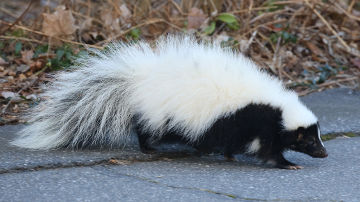Village News

PHOTO COURTESY OF GARRY KESSLER
Striped skunks, who don’t hibernate but do sleep quite a bit during the winter, sometimes wake up long enough during a warm spell in February
February 19, 2021, Page A4
NATURE NOTES
By Annie Reid
Westborough Community Land Trust
Signs of Spring in February
Is February the dead of winter? Or does that honor belong to January?
When you look out the window or get outside this month, check for hints that the natural world is beginning to come to life. For instance, you might see – or smell – your local skunk.
Our native striped skunks (Mephitis mephitis) don’t hibernate, but they do spend much of the winter sleeping and living off their fat. They can lose up to 50 percent of their weight over the winter. They save energy by lowering their body temperature during winter sleep by about 10 degrees. From time to time, they wake up and sometimes emerge from their burrows during a warm spell.
You may not have been surprised if you caught a whiff of skunk around Valentine’s Day. In February skunks have an extra reason to get up and out: it’s the beginning of their mating season (February-April). After mating, the female goes back to her burrow and the male continues to look for other females for a while before disappearing underground until spring. Baby skunks are born in May-June.
Skunks have few predators, thanks to their chemical defenses – the foul-smelling, stinging spray that they can aim toward an attacker’s eyes – but they can be taken by large birds of prey that attack from the air. As it happens, owls and red-tailed hawks become more active around the time that skunks emerge in February. Great-horned owls start their own breeding season in late January – you might hear them hooting “hoo-hoo-HOO-hoo.” Barred owls, whom you might also hear, begin courting in February.
You might notice our year-round birds in February. Flocks of hungry robins and cedar waxwings descend on crab-apple trees and sumacs to strip them of dried fruit or berries.
Listen for the coo of a mourning dove, the beginnings of song from a cardinal, the first whistled “hey sweetie” songs of black-capped chickadees, and the whistles of European starlings that may already be migrating northward. The increasing daylight stimulates certain hormones in songbirds, and these in turn stimulate the growth of the song centers in the birds’ brains, and songs begin.
When snow melts near tree trunks on sunny days, soot-like black specs turn out to be tiny “snow fleas,” or springtails. You might see them jumping around.
As swampy areas thaw, skunk cabbage pokes up, generating enough heat to melt snow as it grows.
February’s full moon is traditionally known as the snow moon, and rightly so, as we’ve been reminded this year, but in some years, a February warm spell brings out pussy willows.
Even under the ice in our local vernal (spring) pools, tiny fairy shrimp hatch from eggs that have lain dormant all winter. They appear as if by magic, tinting the water orange.
If we get a few warm days with cold nights near the end of the month, maple sap begins to flow.
Late in the month, if it’s warm, you might even spot a mourning cloak butterfly fluttering in the woods or feeding at tree sap, a mud puddle, or even animal dung.
It’s not so hard to get through February if you watch nature.
Date index
Month (February)
Common name index
Scientific name index
Category index